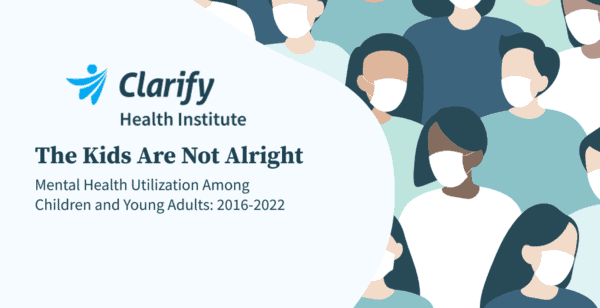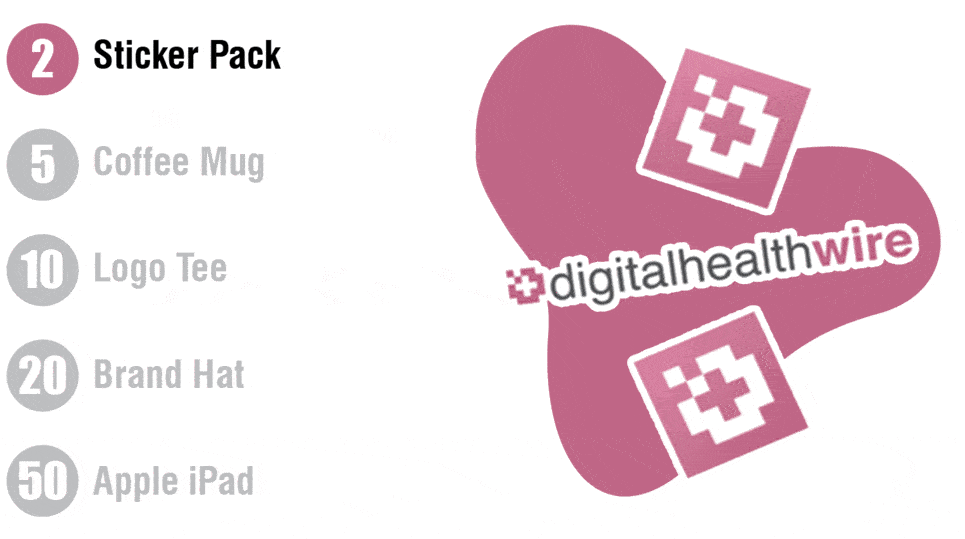|
Youth Mental Health | Hippocratic AI
May 22, 2023
|
|
|

|
|
Together with
|

|
|
|
“At risk is no risk.”
|
|
Transcarent CEO Glen Tullman on how owning risk is key to owning the patient relationship.
|
|

|
|
The youth mental health crisis is past the tipping point. The number of mental health hospitalizations among children and young adults doubled between 2016 and 2022, with inpatient stays for anxiety-related issues and eating disorders tripling over the same period.
That’s according to an analysis of claims data for over 24M Americans under the age of 21 in the new The Kids Are Not Alright report from Clarify Health Institute, whose high quality research is matched only by its stellar report titles.
To frame up just how dire the youth mental health crisis has gotten (2016-2022):
- Clarify found a 124% overall increase in mental health inpatient (IP) hospital admissions
- A 250% increase in IP admissions for anxiety and fear-related disorders
- A 221% increase in IP admissions for feeding and eating disorders
- A 96% increase in IP admissions for depressive disorders
- A 45% increase in mental health ED visits, including a 74% increase for suicidal ideation, attempts, and other self-harm
Looking at the annual incidence rates between conditions (vs. the utilization stats above), Clarify found a steep climb in new diagnoses for 8 of the 9 leading disorders:
- Feeding and eating disorders had the highest rate of growth (44%), followed by anxiety and fear disorders (40%), and obsessive-compulsive disorders (38%).
- Only diagnoses for disruptive and conduct disorders decreased (16%) between 2016-2022, although some volatility in diagnosing was seen at the start of the pandemic (Ex. anxiety conditions saw a 14% decrease in 2020, followed by a 36% YoY increase).
Another interesting slice of the data highlighted the differences in mental health IP utilization by age and sex, showing a particularly tough increase for girls between the ages of 12 and 18.
- IP admissions for adolescent girls were twice as high as boys in the same age group across the entire time period (27 vs 11 per 1k), with Clarify pointing to ubiquitous social media as a primary contributor.
The Takeaway
If the goal of Clarify’s report was to provide a clearer picture of youth mental health care utilization, it succeeded by highlighting just how bleak the current landscape looks. It’s well known that the pandemic didn’t do younger generations’ mental health any favors, but these statistics are a stark reminder that there’s an urgent need to heed the calls-to-action from groups like these pediatric mental health societies and the Surgeon General.
|




|
|
Selecting Your Drug Database and CDS Solution
Do your providers need easy access to real-time drug knowledge and clinical decision support? Explore Synapse Medicine’s complete guide to drug database advantages, use cases, challenges, and factors to consider when selecting the right solution for your organization.
|
|
Clinical Documentation Integrity For VBC
The growing use of risk-adjusted reimbursement in outpatient settings means clinical documentation needs to keep up, or health systems risk leaving revenue on the table. Check out Nuance’s new blog to learn how shifting reimbursement models make clinical documentation excellence more important than ever, and how AI can help you achieve it.
|
|
Better Diabetes Management With Glooko
Glooko’s diabetes management platform transforms the way patients connect with their providers, driving better engagement, adherence, and ultimately outcomes. Take a look at Glooko’s latest clinical studies to see how their platform is driving sustained improvements for people with diabetes.
|
|
- Hippocratic AI Debut: Hippocratic AI emerged from stealth with a whopping $50M in seed funding to build a large language model fine-tuned for healthcare. The Hippocratic model focuses on both proper bedside manner and accuracy ensured through reinforcement learning from human feedback (RLHF) performed by medical professionals – a strategy that currently outperforms GPT-4 on 105 of 114 healthcare certifications. In a16z’s investment thesis, it laid out how generative AI companies like Hippocratic are perhaps the most promising path to solving the healthcare labor shortage.
- Suki Integrates With Epic: Suki announced a blockbuster partnership that’ll see its AI-powered voice assistant integrated directly within Epic’s EHR. The integration supports all Suki capabilities, including dictation, command modes, and its recently launched ambient note-generation feature that auto-generates clinical notes from patient-provider conversations for physician approval. Suki’s kept consistently ahead of the generative AI wave, and Epic rounds out its existing EHR implementations with Cerner, athenahealth, and Elation.
- Telemedicine Outshines In-Person Cancer Care: New research from Moffitt Cancer Center suggests that telemedicine experiences consistently outperform in-person visits for cancer care when both are available. Analyzing patient surveys across over 50k visits, 75.8% of telemedicine patients were highly satisfied with their access to care (vs. 62.5% of in-person patients) and 90.7% were highly satisfied with the amount of concern demonstrated by their provider (vs. 84.2%). Although providers have typically been averse to tele-oncology, the modality is proving effective for certain parts of the cancer care journey.
- Validic Acquires Trapollo: Personalized care company Validac acquired tech support and device logistics provider Trapollo to help its patient monitoring IoT service reach a broader audience. Validic’s platform incorporates data from hundreds of integrations with popular home health devices into a dashboard that lets clinicians personalize care, and Trapollo’s flexible fulfillment and support capabilities will support scaling to larger populations.
- HealthSnap Raises $9M: Virtual care management platform HealthSnap snapped up $9M in a financing round led by Steve Cashman, a proven operator who guided Caption Health through its recent acquisition by GE HealthCare. The funding will be used to help HealthSnap expand its remote patient monitoring and chronic condition management services nationwide after tripling its revenue last year – a result of it demonstrating meaningful clinical improvements across conditions such as hypertension, heart failure, obesity, and Type II diabetes.
- Pharmacies for Healthcare: More patients are looking to retail pharmacies for convenient care options, according to Wolters Kluwer’s latest Pharmacy Next survey. Over half of Americans (58%) are likely to visit a pharmacy as a first step for non-emergency medical issues, and 81% trust a pharmacist or nurse to diagnose minor illnesses and prescribe treatments. The “convenience preference” was especially apparent in younger generations, with 56% of Gen Z and 54% of Millennials visiting a pharmacy to receive care in the past year (vs. 40% of Gen X and 35% of Boomers).
- Included + DispatchHealth: Virtual care company Included Health is pushing deeper into the home care arena through a partnership with DispatchHealth that’ll bring on-demand in-home visits to Included Health’s virtual primary care patients. The new virtual-to-home care model allows patients to request a home visit from DispatchHealth’s mobile teams of medical professionals (usually NPs and PAs), who will then be able to coordinate with Included’s primary care physicians to avoid unnecessary trips to the ED.
- Laguna Health Series A: “Contextual care” startup Laguna Health closed $15M in Series A funding to integrate medical care plans with social, emotional, and cultural factors to help care managers better support patients’ recovery and hospital transitions. Laguna’s platform delivers insights into patients’ life circumstances, helping identify risk barriers and personalize care plans by going beyond SDOH with behavioral, cultural, and spiritual life context.
- Healthcare Perception Survey: One fifth of Americans say US healthcare is in a “state of crisis,” according to Gallup’s 2023 Health and Healthcare survey. Less than half now rate US healthcare quality as excellent or good, while 21% called it poor – the highest percentage in the survey’s 21 year history. Cost was frequently cited as a primary driver for the souring perceptions, with 76% of respondents reporting general dissatisfaction with the cost of healthcare in the US, and 34% dissatisfied with the cost of their own care.
- Datavant AWS Partnership: Datavant is partnering with Amazon Web Services to let healthcare and life sciences organizations connect to hundreds of real world data partners in the Datavant ecosystem through AWS Clean Rooms, allowing them to analyze the datasets without having to copy them or move them outside of AWS. By using Datavant’s tech and AWS Clean Rooms within their own AWS environment, organizations can de-identify, link, and collaborate on their data while retaining control over how it’s used, such as only allowing certain query patterns to generate aggregate statistics.
|
|
3 Ways to Ease the Pain of Provider Credentialing
Is provider credentialing adding cost and time to your bottom line? Check out Medallion’s new blog for three ways to ease the pain of provider credentialing so that you can focus on delivering quality care.
|
|
Clear Arch Health Reduces Readmissions at Altru
When Altru Health System set out to reduce hospital readmissions, it turned to Clear Arch Health to find the solution. Learn how Clear Arch Health’s complete RPM platform and clinical monitoring system helped Altru lower readmissions while improving post-acute care quality.
|
|
The New Staffing Landscape With connectRN
Flexibility is a key component of enabling nurses to deliver their best care without getting burned out. In this Digital Health Wire Q&A, we sat down with connectRN CEO Ted Jeanloz to discuss technology’s role in solving healthcare’s staffing challenges and the new ways that human-centered design can help support nurses.
|
|
|
Share Digital Health Wire
|
|
Spread the news & help us grow ⚡
|
|
Refer colleagues with your unique link and earn rewards.
|

|
|
|
|
Or copy and share your custom referral link: *|SHAREURL|*
|
|
You currently have *|REFERRALS|* referrals.
|
|
|
|
|